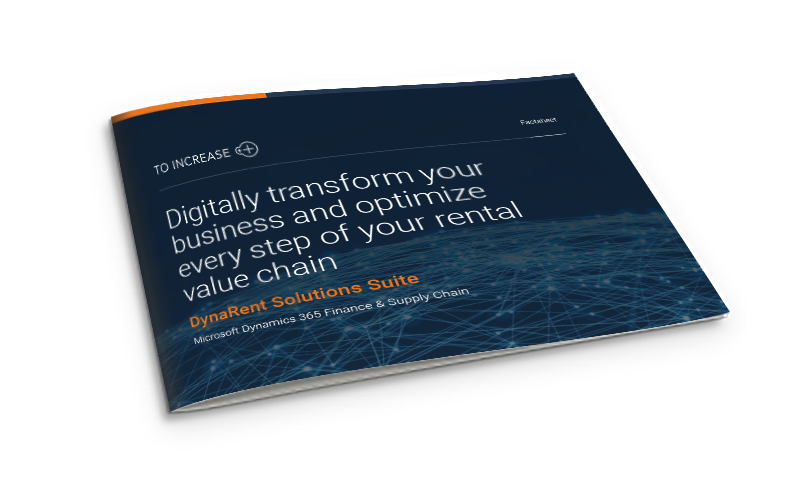Equipment rental companies deal with serialized equipment, non-serialized/ bulk equipment, or have a mix of both in the inventory. The most crucial aspect of your rental inventory is its proper management. Without it, you will not know how many assets you have, which ones you can use safely, and whether some equipment even pays off.
Having been in the industry for over 18 years, we have seen how rental companies struggle to manage their inventory, especially when dealing with serialized and non-serialized assets.
This article will share an overview of the difference between serialized and bulk rental inventory; so, you know how to manage them and implement a potential solution that can handle it all.
Inventory in an equipment rental business
An equipment rental company utilizes the physical assets in its inventory to generate revenue by renting or selling them. Managing your inventory would include sourcing, storing, tracking, scheduling, maintaining, and reusing your equipment as effectively as possible.
Typically for a rental business, two types of items exist in the inventory.
1. Serialized inventory items
2. Non-serialized/ bulk inventory items
What is serialized rental inventory?
Serialized rental inventory items have individual serial units, each with its unique identifier or barcode. This serial number is linked to only one asset that holds information of details such as the type, manufacturer, distributor, and usage and maintenance history.
Serialized products have a separate inventory movement for the total amount ordered, because of which you can scan each item individually, based on which you can ship and pack each product/ equipment.
While renting serialized inventory, each rental object is related to one unique identification number, such as a license plate number or a randomly generated unique serial number. Transactions with serialized items can only be executed when the serial number is filled.
Serialized inventory management for rental companies
Serialized rental inventory management is useful for businesses dealing with high-value equipment or tools requiring unit-level tracking. Tracking each item's usage, maintenance, and repair history makes it easier to identify issues and maintain the equipment.
This allows you to track the equipment's condition, schedule necessary maintenance or repairs, and identify lost or stolen items, reducing the risk of theft.
This type of inventory management is commonly used in the construction industry, high-tech equipment, medical devices, and heavy machinery.
|
Related reading: 5 Benefits of Serialized Inventory Tracking for High-tech and Medical Companies |
What is non-serialized rental inventory?
Also known as bulk rental inventory, these items do not have serial numbers or individually barcoded units assigned to them. In bulk rental stock, items are rented out as a group or bundle.
It is more of a generic inventory wherein one type of item can be replaced or exchanged for an alternate item from a different supplier.
Usually, bulk products have one inventory movement under the total amount ordered and are accounted for by units of measure in weight, height, or number. You often ship, pack, and rent out bulk products together.
When renting non-serialized items, one rental object will have one related fixed asset but could have multiple available quantities. Transactions can be done after an availability check without registering UID numbers per piece.
Non-serialized inventory management for rental companies
Bulk rental inventory management is suitable for businesses that usually deal with lower-value items not requiring tracking at the individual level.
In bulk rental inventory management, you handle inventory of enormous volumes. Since there are no unique labels, monitoring every piece of equipment logistically and financially can be challenging.
Companies usually categorize equipment by type, size, and usage to track which equipment is available for rent and which is currently being used or undergoing maintenance.
This type of inventory management is commonly used when items are rented out in large quantities. Examples include wires, cables, faceplates, scaffolding, generic tools, etc.
What are the challenges of serialized and bulk rental inventory management?
Challenges of managing serialized rental inventory
Managing serialized rental equipment inventory can be complex; you must ensure that each piece of equipment is properly maintained, available when needed, and utilized efficiently.
Serialized inventory management presents its own set of challenges, including:
- End-to-end equipment tracking
- Complying with local and global regulations
- Maintaining detailed documentation for products
- Theft prevention
- Secure storage facilities
- Managing mass returns
Challenges of managing bulk rental inventory
Managing bulk rental equipment can be daunting as it requires careful planning and organization of large volumes with multiple teams.
Some of the challenges that come with managing bulk rental equipment are:
- Tracking equipment location and utilization
- Maintaining and repairing items timely
- Checking availability to plan equipment
- Moving and transporting massive quantities
- Forecasting customer demand
- Losing equipment due to multiple projects
How can rental companies manage serialized inventory
Serialization
Create and assign unique identifiers to your fleet to track it throughout its rental lifecycle, easing daily operations and ownership identification.
Keep accurate records
Record all rental transactions, including the rental date, contract period, and customer information. Detailed documentation with equipment history helps you stay updated on different regulations to comply with.
Conduct regular inventory checks
Periodically count the items and validate the numbers against your stock to confirm that all your serialized equipment is accounted for. This will help you identify any missing or stolen equipment and take appropriate action.
Scan equipment for quick processes
Invest in a scanning solution that can scan each rental item individually and, upon return, give information on which serial number belongs to what project or rental order.
Consolidate operations
Use a single technology stack offering one version of the truth that standardizes business processes of determining the rental rates and ensuring your equipment is properly insured.
Use IoT to track equipment
Equipment tracking and monitoring help you stay updated on your equipment's availability, location, and utilization. Track your equipment comprehensively through IoT sensors to avoid loss in your fleet.
How can rental companies manage bulk inventory
Schedule maintenance and repairs
Schedule regular maintenance and repairs of your equipment to ensure it remains in good condition. Develop a maintenance schedule for each type of equipment and keep records of all maintenance activities.
Plan equipment availability in advance
Use software offering visual summaries of the availability, applicable maintenance tasks, and utilization for each piece of equipment, resulting in efficient planning and scheduling.
Forecast demand with data-based analytics
Use analytics and business intelligence to get insights into asset performance, utilization rates, booking trends, etc., to calculate customer demand.
Streamline rental logistics
Simplify planning, logistics, and transportation of assets with transport planning, real-time scheduling, and mobile apps showing transport tasks for easy deliveries.
Is there a solution that can manage serialized and non-serialized inventory?
As a rental business, you could have serialized items, non-serialized items, or both in your inventory. However, it is important that you are able to manage serialized and non-serialized inventory in one system with ease.
A cloud-based rental ERP software solution that can manage both serialized and non-serialized inventory is the answer.
Using a rental management solution, you can get the best of both worlds and automate all your business processes in one go.
We at To-Increase can help streamline rental inventory management and many other processes, such as finance, human resources, supply chain, etc., in your rental business with our solution: DynaRent, embedded in Microsoft Dynamics 365 for Finance and Supply Chain Management.
To know how DynaRent can ease your rental inventory management, check out:
- Inventory management in DynaRent
- Scanning solution in Dynamics 365 for DynaRent
- Mobile app for field engineers for DynaRent
Additionally, you can explore our rental ERP solution features and offerings in the factsheet linked below to see if it is the right fit for your rental business.





